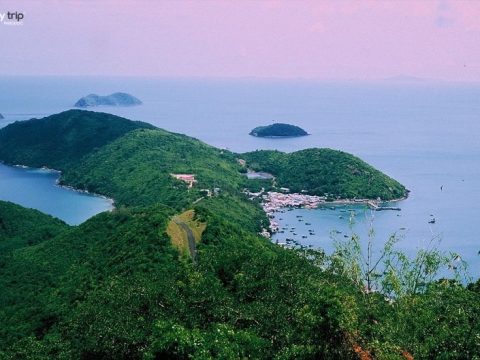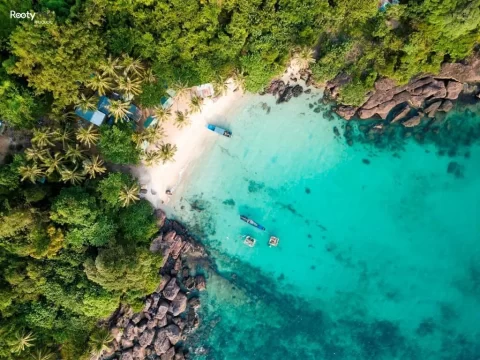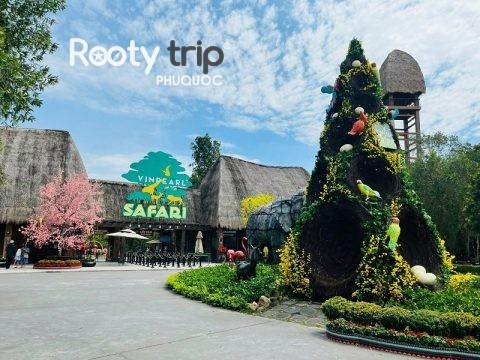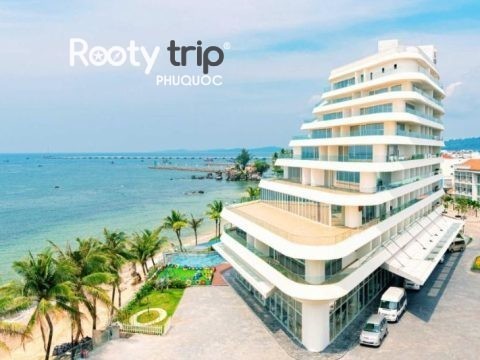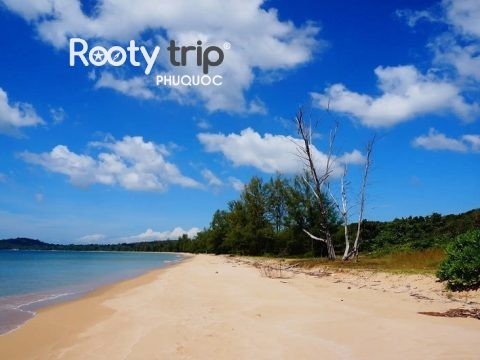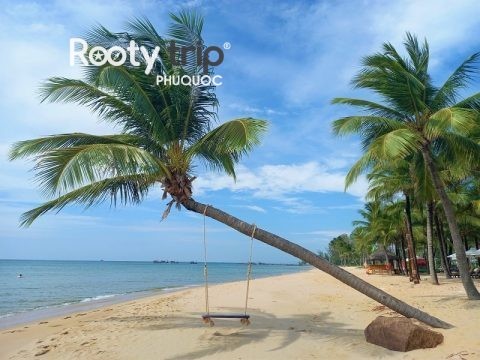Ho Quoc Pagoda Phu Quoc – Iconic Seaside Temple
25/04/2025Spiritual tourism is an unmissable aspect when visiting Phu Quoc. Nestled amidst majestic mountains and the vast sea, Ho Quoc Pagoda-also known as Truc Lam Ho Quoc Zen Monastery-is one of the largest and most beautiful temples on the island. It serves as both a sacred spiritual destination and a place to admire serene natural landscapes. Not only attracting Buddhist pilgrims, Ho Quoc Pagoda is also an ideal stop for travelers seeking tranquility or exploring traditional Vietnamese architecture.
Introduction to Ho Quoc Pagoda
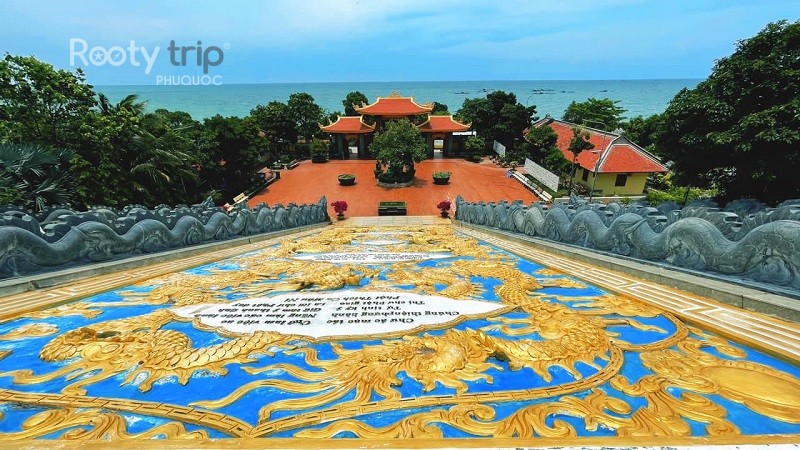
Where is Ho Quoc Pagoda located?
Ho Quoc Pagoda, the largest temple in the Mekong Delta region, spans a total area of 110 hectares. Located in Suoi Lon Hamlet, Duong To Commune, on the southeastern coast of Phu Quoc Island, the pagoda is approximately 10 km from Phu Quoc International Airport and about 20 km from Duong Dong Town. Its strategic position offers visitors a harmonious blend of spiritual ambiance and breathtaking natural scenery.
Construction timeline and purpose
Construction of Ho Quoc Pagoda commenced on October 14, 2011, and was completed by December 14, 2012, with an investment exceeding 100 billion VND, including infrastructure development. The pagoda is part of a nationwide initiative to develop Truc Lam Zen Monasteries, aiming to revive the Truc Lam Yen Tu Zen sect and promote Buddhist values intertwined with national traditions. Beyond serving as a place of worship for locals and tourists, the pagoda contributes to preserving Vietnam’s cultural and spiritual heritage on one of its most beautiful islands.
Significance of the Name “Ho Quoc”
The name “Ho Quoc” translates to “Protecting the Nation,” symbolizing a sacred aspiration for national peace and security. It reflects Buddhism’s noble mission to safeguard the country and guide people toward truth, goodness, and beauty. This name also evokes the spirit of national protection and public welfare emphasized by the Tran dynasty kings in Vietnamese history.
Cultural Role in Phu Quoc
Ho Quoc Pagoda is not only a spiritual destination but also a guardian of traditional values through its architecture, rituals, and annual Buddhist activities. In the lives of Phu Quoc residents, the pagoda serves as a symbol connecting spirituality, culture, and nature. With its “mountain-back, sea-facing” position, the pagoda holds auspicious feng shui significance, bringing peace and prosperity to the Pearl Island.
Architectural highlights of Ho Quoc Pagoda
Ly – Tran dynasty architectural style
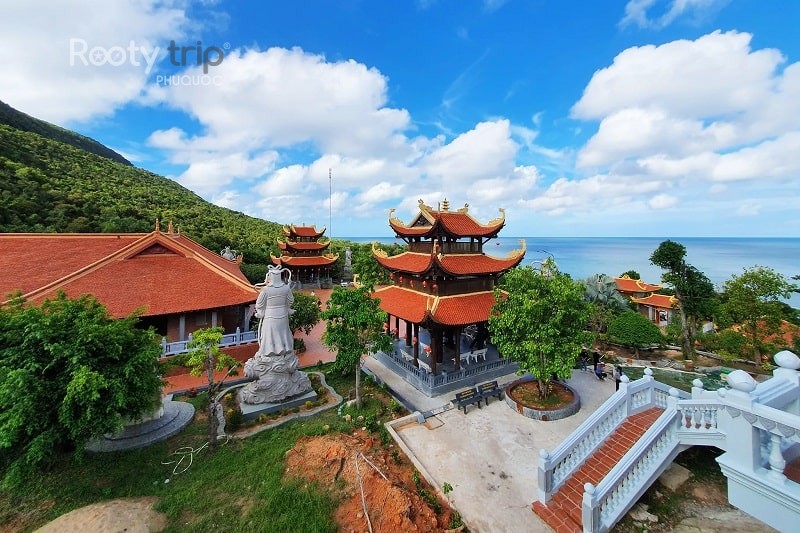
Ho Quoc Pagoda is designed in the traditional architectural style of the Ly – Tran dynasties, characterized by its majesty, solid structure, and elegant lines. This era marked a golden age of Vietnamese Buddhism, so the architecture reflects not only aesthetic value but also the serene essence of Zen Buddhism. From gracefully curved dragon-tail roofs to intricate decorative motifs, every detail embodies sacredness and ancient charm.
Key structures of the Pagoda
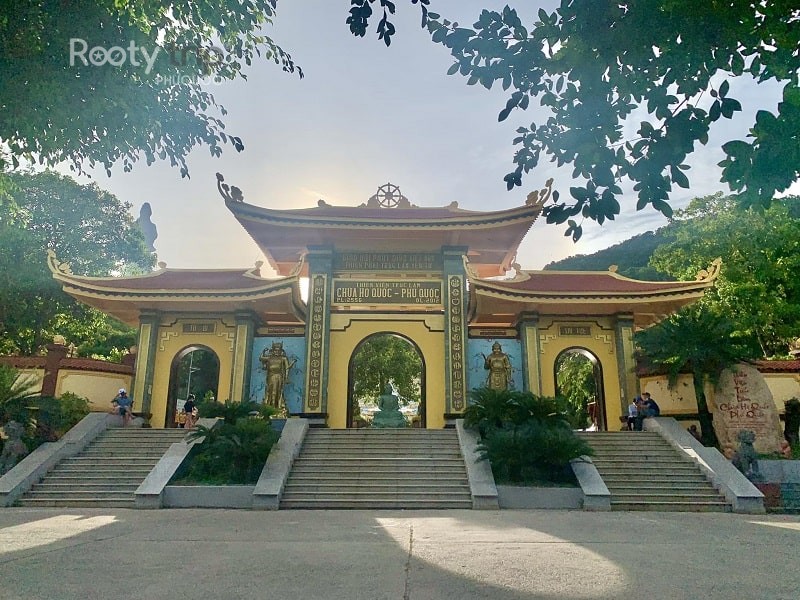
- Tam Quan Gate: The first structure welcoming visitors, built with three grand entrances symbolizing the “Three Doors of Liberation” – Emptiness, Signlessness, and Wishlessness. Reflecting the Truc Lam Zen tradition, the red-tile curved roof is stylized with dragon-head motifs. In the center hangs a sign engraved with gold letters:
“VIETNAM BUDDHIST SANGHA – TRUC LAM YEN TU ZEN MONASTERY”
“TRUC LAM ZEN MONASTERY – HO QUOC PAGODA”
Flanked by statues of Weituo Bodhisattva (Protector of Virtue) and Skanda Bodhisattva (Subduer of Evil), the gate evokes solemn tradition and protection.

- Bodhi Tree Buddha Statue & Dragon Corridor: After the gate, a large red-brick courtyard leads to the Dragon Carpet path. Facing you is a statue of Buddha meditating under the sacred Bodhi tree. The dragon carpet features carved lotus and dragon patterns etched onto a 70-step-long white stone platform leading to the main hall. The stair railings are adorned with stylized dragon sculptures reminiscent of the Tran dynasty.
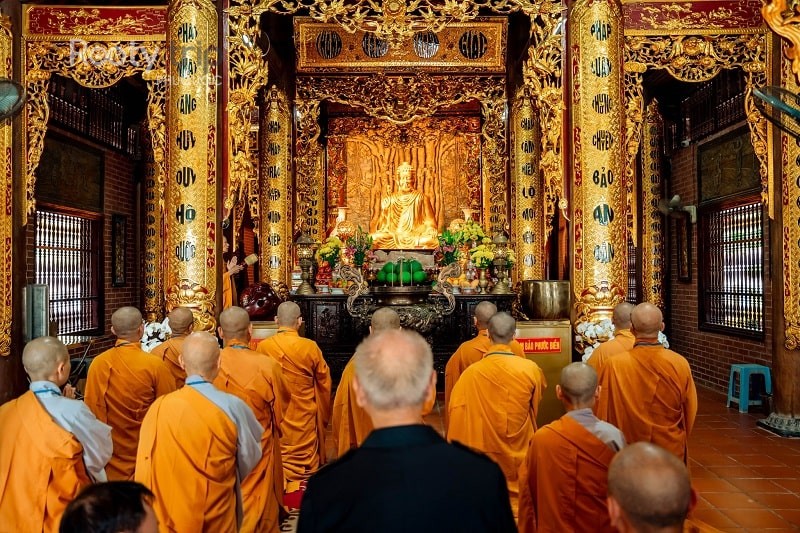
- Main Hall (Dai Hung Bao Dien): The spiritual heart of the pagoda, housing a statue of Shakyamuni Buddha and the patriarchs of Truc Lam Zen. The hall exudes solemnity, and visitors can also venerate the Buddha’s relics and a jade Buddha statue donated by former Prime Minister Nguyen Tan Dung during the pagoda’s inauguration.
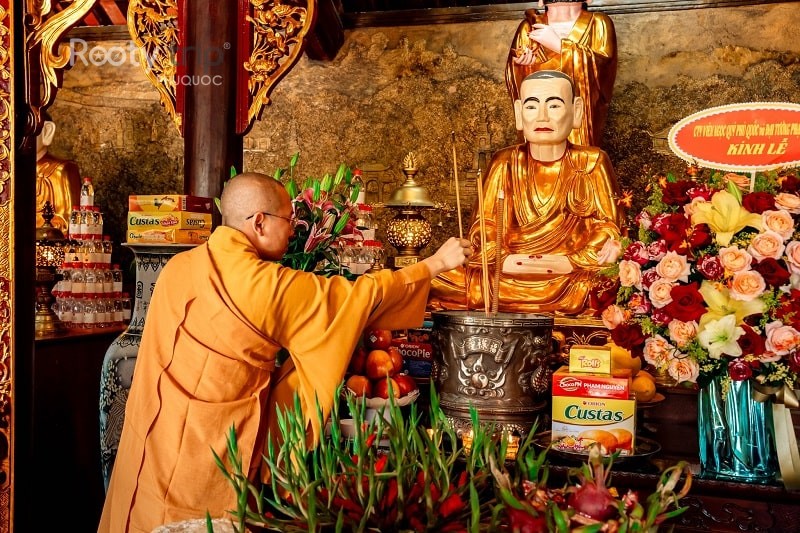
- Patriarch Hall (To Duong): This hall honors the three esteemed patriarchs of Truc Lam Zen: Tran Nhan Tong, Phap Loa, and Huyen Quang, founders and developers of the Vietnamese Zen tradition.
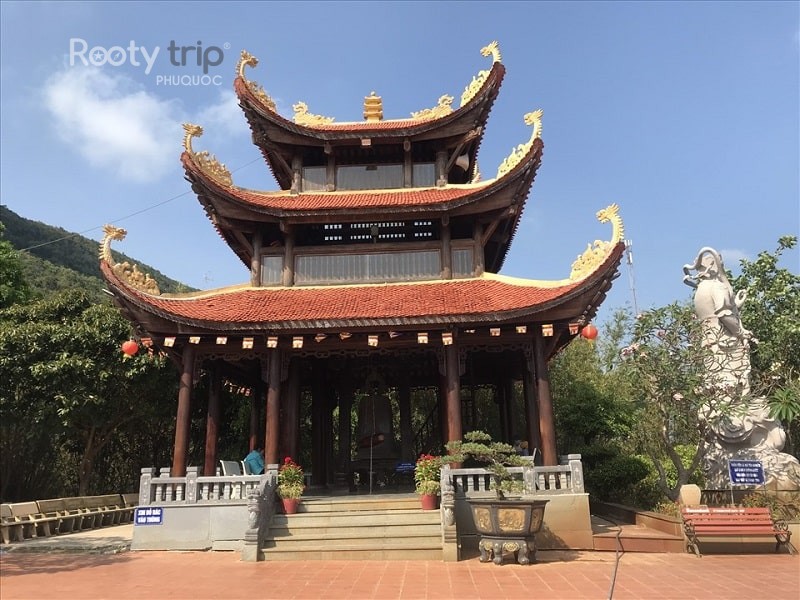
- Bell Tower and Drum Pavilion: Positioned symmetrically on either side of the main hall, these structures enhance the overall harmony of the complex. The echo of the bronze bell evokes a sense of peace and reflection. Surrounding the pagoda are sculpted stone statues of Dharma protectors and Arhats, each uniquely crafted to reflect their spiritual attributes.
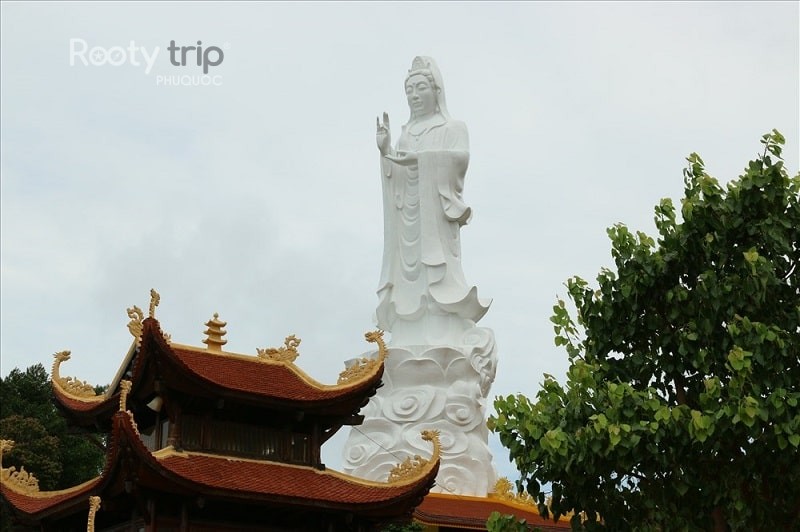
- Guan Yin Bodhisattva Statue Facing the Sea: A majestic 30-meter white statue of Guan Yin looks out over the sea, offering spiritual protection to the island. It is also a symbolic and photogenic spot for visitors.
Exquisite building materials
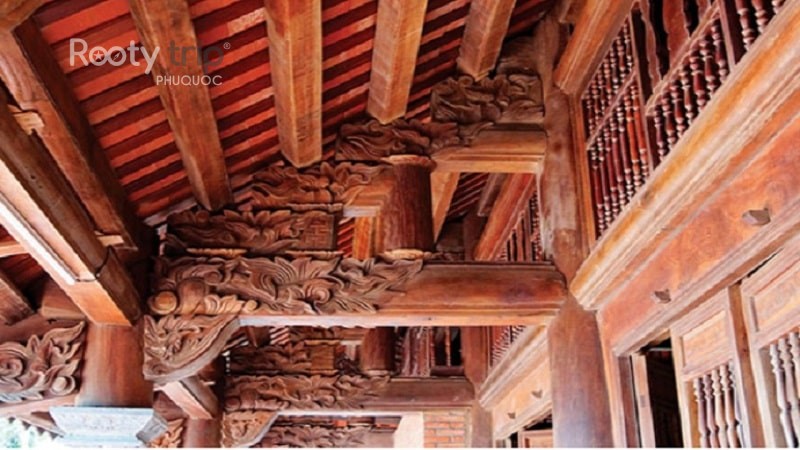
The pagoda is primarily built using precious lim wood, offering a rustic yet enduring charm. Many features are finely carved from monolithic stone, illustrating Buddhist tales and traditional motifs. The harmony between premium materials and exceptional craftsmanship has resulted in a sacred space that is both ancient and monumental, nestled gracefully within Phu Quoc’s stunning landscape.
Spiritual significance of Ho Quoc Pagoda
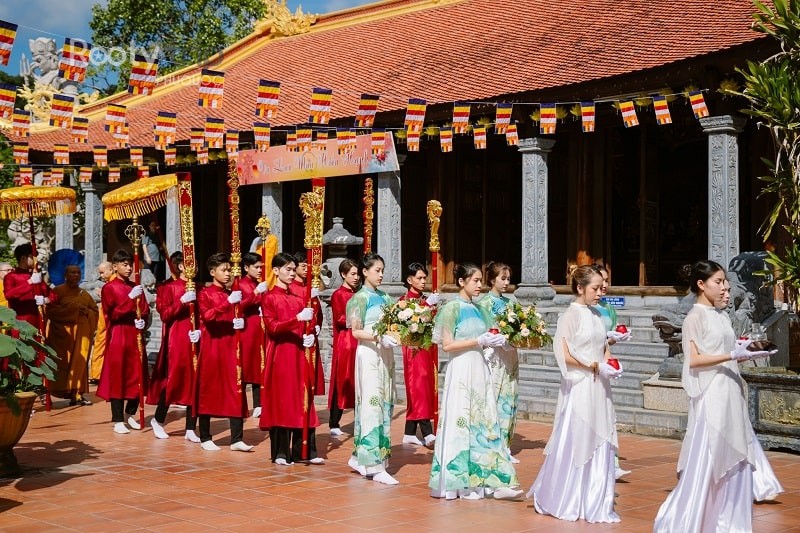
Role in Vietnamese Buddhism
Ho Quoc Pagoda is not merely a tourist attraction but also an important Buddhist learning and spiritual center in Phu Quoc. With its grand scale and Zen-influenced architecture, the pagoda helps spread and preserve the core values of Buddhism in modern life. It stands as a symbol of the harmony between religion and daily life-a place where people seek peace, practice virtue, and nurture their spirit.
Worshiping the three patriarchs of Truc Lam Zen
One of the key spiritual aspects of Ho Quoc Pagoda is its dedication to the three revered founders of the Vietnamese Truc Lam Zen lineage:
- Tran Nhan Tong – A wise king who abdicated the throne to become a monk and founded the Truc Lam Zen school.
- Phap Loa – His excellent successor, who expanded the influence of Truc Lam Buddhism.
- Huyen Quang – The third patriarch, admired for his profound wisdom and virtue.
Honoring these figures is not only a gesture of gratitude but also affirms the role of Truc Lam Zen in preserving both Buddhist principles and national culture.
Ceremonies and spiritual activities
Every year, Ho Quoc Pagoda holds major Buddhist festivals such as:
- Vesak Day (Buddha’s Birthday – 15th of the 4th Lunar Month)
- Vu Lan Festival (Ghost Festival – 15th of the 7th Lunar Month)
- New Year’s Blessing and Memorial Ceremonies
Visitors and devotees can also join chanting sessions, meditation classes, or simply offer incense and prayers for peace and blessings for themselves and their families. The tranquil, sacred atmosphere and the warm guidance of the monks make Ho Quoc Pagoda a place where one can reconnect with inner peace.
Make the most of your island getaway with a Phu Quoc snorkeling tour, guided by local experts.
Visitor guide Ho Quoc Pagoda

Location and directions
Visitors can easily reach the pagoda by motorbike, taxi, or private car via the DT46 road toward Bai Sao and Bai Khem beaches.
From Duong Dong Town, there are two main routes:
- Take DT47 (Suoi Tranh road), turn right at the roundabout onto DT47 (Nguyen Van Cu Road), and then turn left at the signpost for Ho Quoc Pagoda. Continue until you reach the pagoda.
- Alternatively, take Tran Hung Dao Street to the international airport roundabout, turn left onto Nguyen Van Cu Road, and follow the same route as above.
Opening hours & admission
- Opening hours: 6:00 AM – 6:00 PM daily
- Entrance: Free of charge
- Visitors should maintain a respectful and reverent attitude when entering the temple grounds.
Dress code & etiquette
Wear modest, respectful clothing-avoid shorts, sleeveless tops, and revealing outfits. Use easy-to-remove footwear for convenience. Avoid speaking loudly or taking photos in restricted areas.
Nearby attractions Ho Quoc Pagoda

After visiting Ho Quoc Pagoda, explore these nearby highlights:
- Bai Sao – One of the most beautiful beaches in Phu Quoc with powdery white sand and crystal-clear waters.
- Bai Khem – A hidden gem known for its wild beauty and delicious seafood.
- Phu Quoc Prison – A historical site that recreates the resistance era.
- Sunset Town (Mediterranean-style) – A perfect spot to watch the sunset and snap unique photos.
Travel tips go to Ho Quoc Pagoda
- Best time to visit: Early morning for fresh air and to avoid the midday sun.
- What to bring: Water, sunhat, sunscreen, and a camera to capture stunning memories.
- Be respectful: Don’t litter, avoid making noise, and preserve the sacred space of the temple.
Ho Quoc Pagoda is not just a spiritual sanctuary but also a magnificent architectural marvel nestled in Phu Quoc’s awe-inspiring natural landscape. If you’re planning a trip to this island, don’t miss out on a journey that combines spiritual discovery with cultural enrichment. May your Phu Quoc adventure be joyful and fulfilling!


